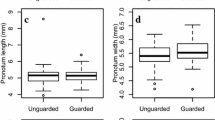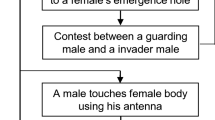Abstract
Males of the territorial libellulid dragonfly Paltothemis lineatipeschange the intensity with which they guard their mates during an oviposition bout. Immediately after copulation is completed, males exhibit strong guarding, remaining very close to their partners as they begin ovipositing. In less than a minute, however, they begin to drift away to resume territorial patrolling or even to perch while their partners continue to oviposit. The duration of strong guarding is not related to how long the male has been on territory. Nor is it an activity of fixed duration set by the release of the female following copulation or by the initiation of oviposition by a panner. Instead, males can extend the period of strong guarding if oviposition is interrupted experimentally early in a bout. Under these conditions, males follow their mates closely until they have found a new location at which they oviposit steadily. Thus, males apparently must see their panner oviposit for some time before reducing the intensity of mate-guarding.
Similar content being viewed by others
References
Alcock, J. (1987). Male reproductive tactics in the libellulid dragonflyPaltothemis lineatipes: Temporal partitioning of territories.Behaviour 103: 157–173.
Alcock, J. (1989). Annual variation in the mating system ofPaltothemis lineatipes (Anisoptera: Libellulidae).J. Zool. 218: 597–602.
Alcock, J. (1990). Oviposition resources, territoriality and male reproductive tactics in the dragonflyPaltothemis lineatipes (Odonata: Libellulidae).Behaviour 113: 251–263.
Convey, P. (1989). Post-copulatory guarding strategies in the non-territorial dragonflySympetrum sanguineum (Müller) (Odonata: Libellulidae).Anim. Behav. 37: 56–63.
Corbet, P. S. (1980). Biology of Odonata.Annu. Rev. Entomol. 25: 189–227.
Dunkle, S. W. (1978). Notes on adult behavior and emergence ofPaltothemis lineatipes Karsch, 1890 (Anisoptera: Libellulidae).Odonatologica 7: 277–279.
Fried, C. S., and May, M. L. (1983). Energy expenditure and food intake of territorial malePachydiplax longipennis (Odonata: Libellulidae).Ecol. Entomol. 8: 283–292.
Koenig, W. D., and Albano, S. S. (1985). Patterns of territoriality and mating success in the white-tailed skimmerPlathemis lydia (Odonata: Anisoptera).Am. Midl. Nat. 114: 1–12.
Marden, J. H. (1989). Bodybuilding dragonflies: Costs and benefits of maximizing flight muscle.Physiol. Zool. 62: 505–521.
McMillan, V. E. (1991). Variable mate-guarding behavior in the dragonflyPlathemis lydia (Odonata: Libellulidae).Anim. Behav. 41: 979–988.
Moore, A. J. (1989). The behavioral ecology ofLibellula luctuosa (Burmeister) (Odonata: Libellulidae). III. Male density, OSR, and male and female mating behavior.Ethology 80: 120–136.
Parker, G. A. (1970). Sperm competition and its evolutionary consequences in the insects.Biol. Rev. 45: 525–567.
Uéda, T. (1979). Plasticity of the reproductive behaviour in a dragonfly,Sympetrum parvulum Barteneff, with reference to the social relationship of males and the density of territories.Res. Pop. Ecol. 21: 135–152.
Utzeri, C., Falchetti, E., and Raffi, R. (1987). Adult behaviour ofLestes barbarus (Fabricius) andL. virens (Charpentier) (Zygoptera, Lestidae).Frag. Entomol. 20: 1–22.
Waage, J. K. (1984). Sperm competition and the evolution of odonate mating systems. In Smith, R. L. (ed.),Sperm Competition and the Evolution of Animal Mating Systems, Academic Press, New York, pp. 251–290.
Author information
Authors and Affiliations
Rights and permissions
About this article
Cite this article
Alcock, J. The duration of strong mate-guarding by males of the libellulid dragonflyPaltothemis lineatipes: Proximate causation. J Insect Behav 5, 507–515 (1992). https://doi.org/10.1007/BF01058195
Accepted:
Issue Date:
DOI: https://doi.org/10.1007/BF01058195




